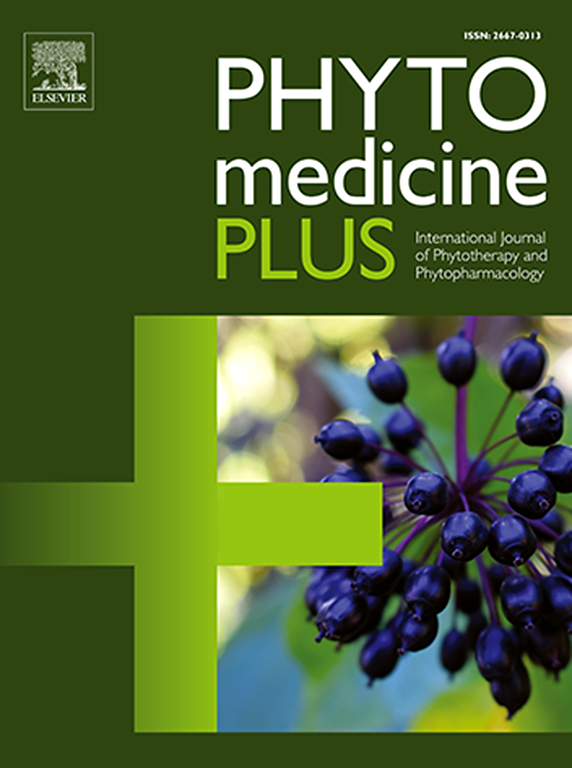Assessing the antiproliferative properties of various teas against the DU-145 prostate cancer cell line: A combined in vitro and in silico investigation
Q3 Pharmacology, Toxicology and Pharmaceutics
引用次数: 0
Abstract
Background
Phytotherapy emerges as a promising solution to the challenges posed by cancer treatment. Black, green, and purple teas, renowned for their antioxidant properties, exhibit efficacy against various cancers, including prostate cancer.
Study Design
This was an experimental study conducted from the Kenya Medical Research Institute (KEMRI).
Aim of the Study
the present study aimed to evaluate the Cytotoxic effect of black, green and purple teas against prostate cancer cell line DU-145 and in silico prediction of Tea catechins interaction with prostate cancer proteins such as 3D-crystal structures of Androgen-receptor(5T8E) and Human p38 MAPK(1KV2).
Methods
The study started by quantifying tea catechins (Epigallocatechin gallate (EGCG), Epigallocatechin EGC, Epicatechin gallate (ECG) and Epicatechin (EC) with high-liquid chromatography (HPLC), cytotoxicity analysis of black, green and purple tea crude extracts against DU-145 cell line at 24hr and 48 hrs by Resazurin assay and molecular docking was performed with Autodock Vina 1.1.2 software.
Results
EGCG appeared the most predominant catechin with 552.2 ± 10.61 (mg g-1 DW) while EC was the lowest detected with 118.08 ± 9.45 (mg g-1 DW). Purple tea extract exhibited high antiproliferative activity with IC50 of 98.69±1.99 µg/ml at 24hr and 91.21±6.91 µg/ml at 48hr, green tea followed with 121 ± 5.97µg/ml at 24hr and 107.1 ± 2.03 µg/ml at 48hr IC50; black tea was the least effective tea at both 24hr and 48hr with IC50 of 290.8 ± 2.46µg/ml and 237.8 ± 5.59µg/ml respectively. Prediction of catechin target genes and Prostate cancer (Pca)-related genes discovered 121 catechin target genes and 34,926 Pca-related genes. EGC exhibited high binding interaction to 5T8E with the lowest affinity of -9.1Kcal/mol followed by EGCG at -8.4 (Kcal/mol then EC with -8.2 (Kcal/mol) and EGC at -8.1 (Kcal/mol). Catechins interaction with 1KV2 was in the following order EGCG (-9.4 Kcal/mol) ˃ECG (-8.2 Kcal/mol) ˃EC (-8.2 Kcal/mol) ˃EGC (-8.1 Kcal/mol).
Conclusion
In vitro experiment detected a very significant antiproliferative activity of black, green and purple tea crude extracts against the DU-145 cell line; furthermore, in silico analysis revealed a strong binding interaction with proteins associated with prostate cancer, indicating that black, green, and purple teas, along with catechins, hold promise as potential herbal remedies for combating prostate cancer.

评估各种茶叶对 DU-145 前列腺癌细胞系的抗增殖特性:体外研究与硅学研究的结合
研究背景植物疗法是应对癌症治疗挑战的一种前景广阔的解决方案。红茶、绿茶和紫茶因其抗氧化特性而闻名,对包括前列腺癌在内的各种癌症都有疗效。 研究设计这是在肯尼亚医学研究所(KEMRI)进行的一项实验研究。研究目的本研究旨在评估红茶、绿茶和紫茶对前列腺癌细胞株 DU-145 的细胞毒性作用,并利用雄激素受体(5T8E)和人类 p38 MAPK(1KV2)的三维晶体结构,对茶叶儿茶素与前列腺癌蛋白的相互作用进行硅学预测。研究首先采用高液相色谱法(HPLC)对茶叶儿茶素(表没食子儿茶素没食子酸酯(EGCG)、表没食子儿茶素EGC、表儿茶素没食子酸酯(ECG)和表儿茶素(EC))进行定量分析,然后用瑞沙唑林检测法分析红茶、绿茶和紫茶粗提取物在24小时和48小时内对DU-145细胞株的细胞毒性,并用Autodock Vina 1.1.2软件进行分子对接。1.2 软件.结果EGCG 是最主要的儿茶素,含量为 552.2 ± 10.61(毫克 g-1 DW),而 EC 的含量最低,为 118.08 ± 9.45(毫克 g-1 DW)。紫茶提取物表现出较高的抗增殖活性,24小时和48小时的IC50分别为98.69±1.99µg/ml和91.21±6.91µg/ml;绿茶次之,24小时和48小时的IC50分别为121±5.97µg/ml和107.1±2.03µg/ml;红茶是24小时和48小时活性最低的茶,IC50分别为290.8±2.46µg/ml和237.8±5.59µg/ml。预测儿茶素靶基因和前列腺癌(Pca)相关基因发现了121个儿茶素靶基因和34,926个前列腺癌相关基因。EGC与5T8E的结合力很高,亲和力最低,为-9.1 Kcal/mol,其次是EGCG,为-8.4 (Kcal/mol),然后是EC,为-8.2 (Kcal/mol),EGC为-8.1 (Kcal/mol)。儿茶素与 1KV2 的相互作用顺序如下:EGCG(-9.4 Kcal/mol)˃ECG(-8.2 Kcal/mol)˃EC(-8.2 Kcal/mol)˃EGC(-8.1 Kcal/mol)。结论体外实验发现,红茶、绿茶和紫茶的粗提取物对 DU-145 细胞株具有非常显著的抗增殖活性;此外,硅学分析表明,红茶、绿茶和紫茶与前列腺癌相关蛋白具有很强的结合相互作用,表明红茶、绿茶和紫茶以及儿茶素有望成为抗击前列腺癌的潜在草药疗法。
本文章由计算机程序翻译,如有差异,请以英文原文为准。
求助全文
约1分钟内获得全文
求助全文
来源期刊

Phytomedicine Plus
Medicine-Complementary and Alternative Medicine
CiteScore
3.70
自引率
0.00%
发文量
178
审稿时长
81 days
期刊介绍:
 求助内容:
求助内容: 应助结果提醒方式:
应助结果提醒方式:


